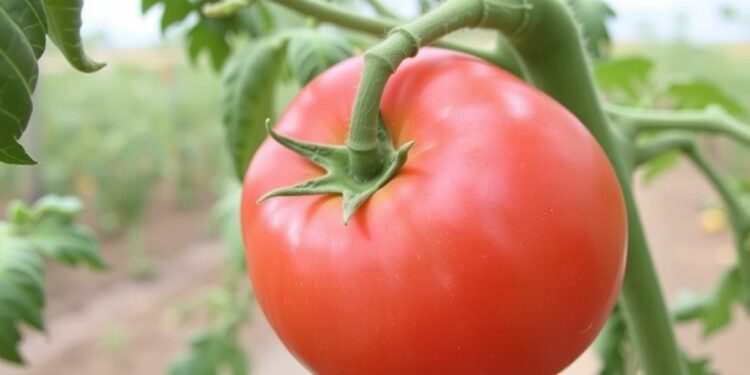Texas A&M AgriLife Research scientists are embarking on crucial research aimed at demystifying and controlling the tomato spotted wilt virus (TSWV), a notorious pathogen known for its devastating impact on crops worldwide. This virus is responsible for significant economic losses in agriculture, with estimates reaching upwards of $1 billion each year. The urgency of this research stems from the virus’s ability to infect over 1,000 plant species, including essential food crops and numerous weeds, making it one of the most economically impactful plant viruses globally.
Leading this initiative is Dr. Kiran Gadhave, a researcher and assistant professor in the Department of Entomology at Texas A&M University. Gadhave’s mission is multifaceted, involving the development of better control strategies for TSWV and enhancing our understanding of the pathogen’s dynamics within its hosts. Recent funding from the U.S. Department of Agriculture (USDA) and the National Science Foundation (NSF) includes a substantial three-year grant of $887,000 dedicated to applied research, alongside another grant of $993,002 aimed at fundamental research into the virus’s characteristics and interactions.
TSWV poses a significant threat not only because of its economic repercussions but also due to its unique biological properties, which allow it to thrive and replicate in both plant and insect hosts. The virus’s primary vector, the western flower thrips, plays a critical role in its transmission, as these minute insects are not only carriers of the virus but also notorious agricultural pests on their own. Understanding the intricacies of this virus’s life cycle is paramount to developing effective management strategies.
The symptoms of TSWV infection are stark and unsettling for agricultural producers. Infected plants often display stunted growth, distinctive mosaic patterns on leaves, and compromised fruit quality characterized by rotting spots or total lack of fruit. Such manifestations render the produce unsalable and drastically impact farmers’ incomes. Unfortunately, the situation is further complicated by the presence of new strains of the virus that have emerged across at least ten countries, which can break through existing resistances in plant cultivars, making previous control efforts ineffective.
The project spearheaded by Gadhave and his team aims to expand our capabilities in managing TSWV through a comprehensive approach. The USDA-funded project is set to benefit a wide range of stakeholders, particularly vegetable growers, by exploring the development of new crop cultivars, establishing improved detection methods for the virus, and providing up-to-date management recommendations grounded in scientific research. Such advancements not only promise to curtail the negative impacts of TSWV on crop yields but also aspire to bolster public knowledge about the challenges posed by plant viruses to global agricultural stability.
Key to this research will be the identification and monitoring of resistance-breaking strains of TSWV in major tomato and pepper-growing regions across the United States. By collaborating directly with growers, researchers will be able to assess economic losses stemming from these viral outbreaks and determine the cost-effectiveness of varying management strategies. This practical approach ensures that outcomes are not merely theoretical but have direct implications for real-world agricultural practices.
Another integral facet of Gadhave’s work involves the development of diagnostic tools capable of reliably detecting resistance-breaking variants of TSWV. This innovation will empower farmers and agricultural practitioners with the necessary information to make timely and informed decisions in the field, thus enhancing their ability to manage outbreaks effectively. Additionally, understanding the transmission biology of these new strains will be critical in disrupting their spread and mitigating their impact on crops.
The NSF-funded component of Gadhave’s research project focuses on fundamental studies that dissect how TSWV interacts with its tomato hosts at a molecular level. This inquiry seeks to unveil the mechanisms by which these new strains overcome the resistance typically conferred by plant genetics. By unraveling the complexities of these host-pathogen interactions, scientists hope to devise strategies to enhance plant defenses and promote resilience against viral infections in agricultural systems.
As the research progresses, expectations are high that outcomes will herald the development of new crop cultivars that possess strong resistance to evolving TSWV strains. Given that the last significant economic assessments regarding TSWV were conducted in the 1990s, this initiative is expected to provide updated data that will guide growers in their management approaches while potentially translating into increased economic returns for the agricultural sector.
The aspirations for educational outreach accompanying this research are equally significant. Gadhave emphasizes the importance of informing the public about the nexus between plant health, agricultural security, and the economic implications of plant viruses. By raising awareness about the struggles faced by growers and the underlying scientific endeavors to support them, the team aims to foster a deeper understanding of sustainable agricultural practices among stakeholders and the general populace.
The long-term vision driving Gadhave’s research encompasses continuous adaptation to the evolving nature of TSWV. Recognizing that this virus is likely to perpetually evolve, researchers are committed to finding sustainable solutions to reduce its economic toll on global agriculture. Through ongoing investigation and collaboration, this project aspires not only to mitigate the immediate threat posed by TSWV but also to elucidate strategies that will safeguard agricultural productivity for future generations.
In summary, the alliance of interdisciplinary expertise brought together through this research initiative exemplifies the collective effort required to tackle one of the most pressing challenges in contemporary agriculture. The findings and innovations generated by Gadhave and his team may serve to not only control TSWV effectively but also pave the way for broader advancements in our understanding of plant viruses and their management in agricultural ecosystems.
Subject of Research: Control and understanding of tomato spotted wilt virus
Article Title: Understanding and Controlling Tomato Spotted Wilt Virus: Texas A&M AgriLife Research Initiatives
News Publication Date: January 14, 2025
Web References: Texas A&M AgriLife Research
References: USDA, National Science Foundation
Image Credits: Surender Kumar, Texas A&M AgriLife
Keywords: Tomato spotted wilt virus, agricultural research, crop management, plant pathogens, resistance mechanisms, viral transmission, interdisciplinary collaboration, sustainable agriculture.





